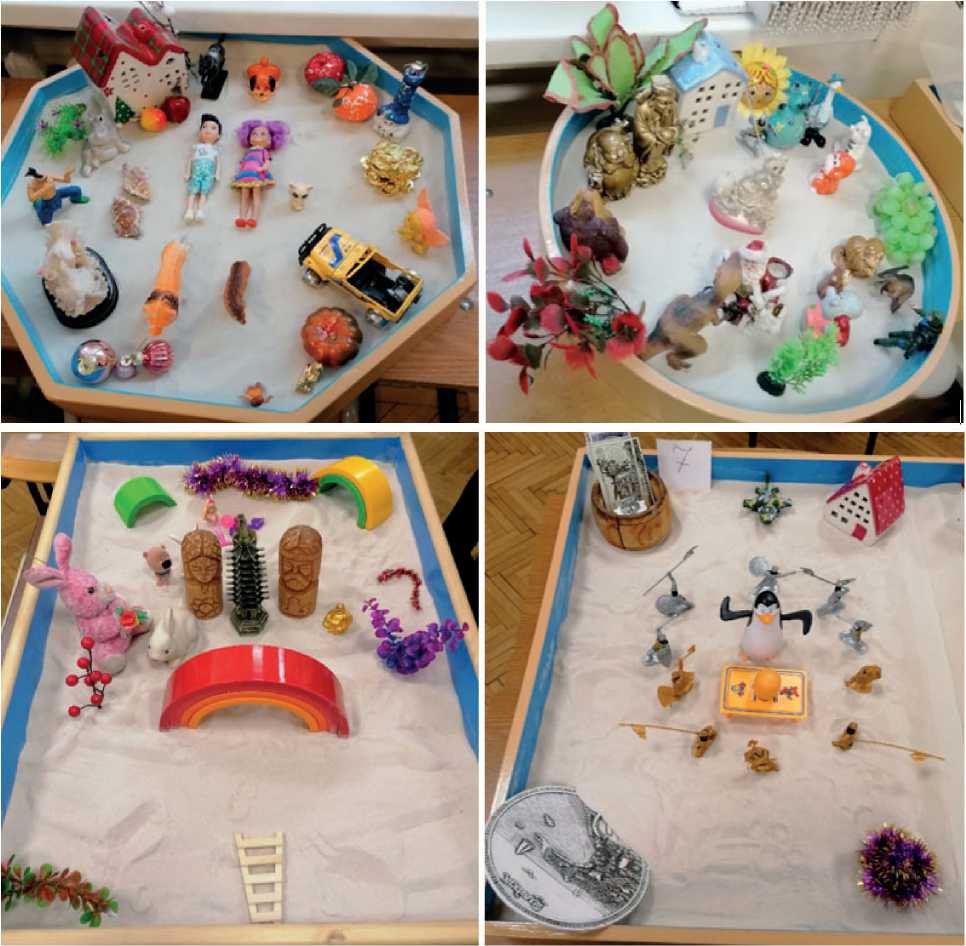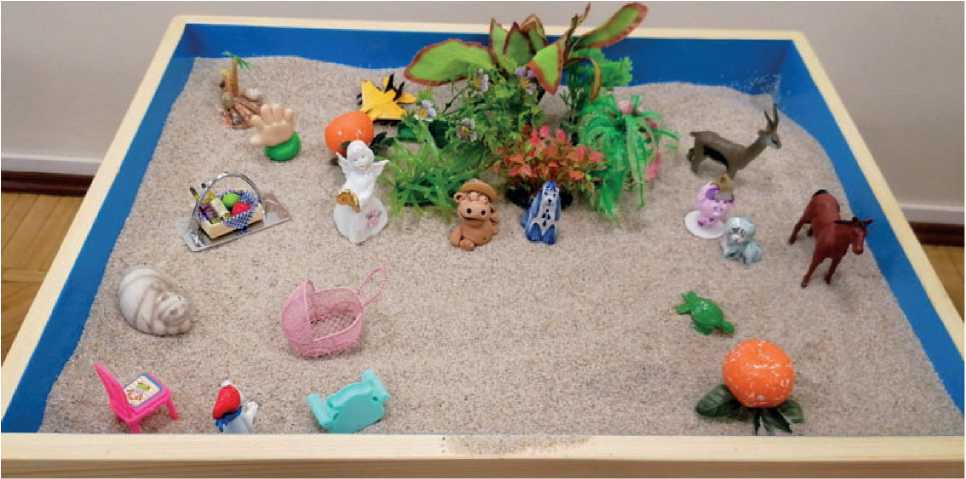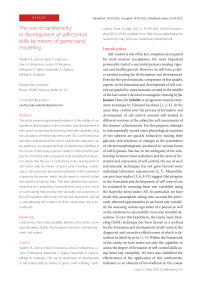The use of cardiometry in development of self-control skills by means of game sand modeling
Автор: Zernov V.A., Lobanova E.V., Likhacheva E.V., Nikolaeva L.P., Ognev A.S., Ogneva N. A., Rudenko M.Yu.
Журнал: Cardiometry @cardiometry
Рубрика: Report
Статья в выпуске: 22, 2022 года.
Бесплатный доступ
The article presents experimental evidence of the validity of our hypothesis that progress in the formation and development of self-control can be fixed by assessing heart rate variability using the calculation of the Baevsky stress index (SI). Confirmation has also been obtained that this sort of cardiometric indicators can be applied as an essential element of effective bio-feedback in the course of improving a person’s ability to control his/her own psycho-emotional state using game sand modeling techniques. It is shown that the use of cardiometry in the development of self-control skills by means of game sand modeling contributes to the systematic phased internalization of the orientation scheme by the person, which he/she needs to control his/her own psycho-emotional state. The data obtained also demonstrate that the cardiometric measurements used in the course of such training help increase the rationality and awareness of the self-regulation skills to be formed and developed, and aid in strengthening the mindset for their constructive use in everyday life.
Cardiometry, heart rate variability, baevsky stress index, game sand modeling (gsm), psychological correction, self-development, self-control
Короткий адрес: https://sciup.org/148324645
IDR: 148324645 | DOI: 10.18137/cardiometry.2022.22.9599
Текст научной статьи The use of cardiometry in development of self-control skills by means of game sand modeling
Vladimir A. Zernov, Elena V. Lobanova, Elvira V. Likhacheva, Lyubov’ P. Nikolaeva, Aleksandr S. Ognev, Nadezhda A. Ogneva, Mikhail Yu. Rudenko. The use of cardiometry in development of self-control skills by means of game sand modeling. Cardi- ometry; Issue 22; May 2022; p. 95-99; DOI: 10.18137/cardiom-etry.2022.22.9599; Available from: issues/no22-may-2022/use-cardiometry-development
Self-control is one of the key competencies required for most modern occupations, the most important personality trait of a successful person enjoying vigorous and healthy growth. However we still have a rather modest tooling for its formation and development. Even for the psychosomatic component of this quality, experts in the formation and development of self-control are guided by some manuals created in the middle of the last century devoted to autogenic training by Johannes Heinrich Schultz or progressive muscle relaxation technique by Edmund Jacobson [1, 2, 4]. At the same time, control over the process of formation and development of self-control remains still limited to different versions of the subjective self-assessments of the trainees’ achievements. For this purpose, attempts to instrumentally record some physiological reactions of test subjects are quickly reduced to tracing their galvanic skin reactions or changes in the parameters of electroencephalograms produced to various forms of self-hypnosis. But due to the ambiguity of the relationship between these indicators and the level of formation and expression of self-control, the use of such instrumental techniques has not gone beyond some individual laboratory experiments [2, 7]. Meanwhile, our previous studies [5, 6, 8-19] suggest that progress in the formation and development of self-control can be evaluated by assessing heart rate variability using the Bayevsky stress index (SI). In particular, we have made this assumption taking into account the previously detected opportunities to use heart rate variability for assessing various ego states of a person as well as the readiness to successfully overcome stressful situations. To test this hypothesis, the Game Sand Modeling (GSM) technique has been chosen as a method for the formation and development of self-control, the diagnostic and corrective effectiveness of which is described in detail by us in [1, 5]. Within the framework of this study, we have tested not only the capability to assess the degree of formation of self-control skills using heart rate variability. We have also identified the effectiveness of the application of this cardiometric indicator as an element of bio-feedback in the course of improving a person’s ability to control his/her own psycho-emotional state using the techniques of game sand modeling.
Materials and Methods
When testing the hypotheses outlined in our study, a series of experiments was conducted, in which first 37 participants in the training sessions chose pairs of toy miniatures to indicate their psycho-emotional states as follows:
-
– 1st pair: extreme self-dissatisfaction and obvious satisfaction with one’s own behavior;
-
– 2nd pair: confusion and, vice versa, a feeling of complete control over the situation;
-
– 3rd pair: experiencing negative and positive emotions.
After that, the participants built their compositions in sand containers, in which it would be convenient for all the toy figurine characters they selected to live. According to the conditions of the experiment, each participant had to transform his/her composition in such a way that it would correspond as much as possible to his ideas about inner harmony, mental balance and a high level of self-control. Then each participant of the training session photographed his/her produced composition with a smartphone. Some samples of the taken pictures are shown in a Figure given herein.
At the second stage, with the use of PC-assisted hemodynamic analyzers Cardiocode, the participants’ reactions were measured to each of the figurines they chose, and subsequently to the image of the composition created with their help, embodying inner harmony, mental balance and a high level of self-control. Using the algorithms embedded in the software of these recording devices, the Baevsky stress index (SI) was calculated for each test subject. The obtained values of SI were further used as individual indicators to show which of the states the currently updated states of this participant were approaching: either a negative or a positive state.
At the third stage, each participant was asked to focus his/her attention on the miniature figurines representing negative emotional states. At the same time, the cardiometric indicators of the reactions initiated by this task were recorded.
At the final stage, each participant was asked to evoke in himself/herself that emotional state that accompanied the fixation on the image of a picture of inner harmony, mental balance and a high level of 96 | Cardiometry | Issue 22. May 2022
self-control. First, the organizers of the experiment asked each participant to use a photo of the corresponding composition. And after receiving cardiometric confirmation that such a state had been really formed the participant was asked to evoke this state only with the help of an image of the situation restored in his/her memory. When the cardiometric indicators turned out to be closer to the initial values obtained during the demonstration of the corresponding images, the respondents were simply asked to induce a state of inner harmony, mental balance and a high level of self-control without any additional stimuli. Such an order of changing the used stimuli, from photographs of the corresponding compositions to the images of these compositions stored in the memory, and then to the memory flashback of the state being formed itself, actually reproduced the procedures of the purposeful internalization of the acquired orientation schemes. As is known, such an approach is widely used in the systematic phased formation of mental actions in the theory by P.Ya. Galperin [3].
The experiment was considered to be completed when the test subject’s cardiometric indicators were found to be closer in their values to the indicators obtained, when demonstrating the image of the picture of inner harmony, mental balance and a high level of self-control, created by the test subject in question, as compared to the indicators obtained by fixing attention on negative psycho-emotional states.
Results and Discussion
For all participants of the described trainings at the final stage, the desired indicators of SI (i.e., close to those that were previously obtained by fixing the attention of the test subjects on the images of those compositions which embodied inner harmony, mental balance and a high level of self-control) were recorded after two or three attempts to recall the desired state from their memory. As a rule, that state corresponded to the values of SI, which ranged from 190 to 480 arbitrary units. For most of the test subjects, fixing attention on the miniature figurines, which implied their negative psycho-emotional states, was accompanied by heart rate fluctuations of the SI values in the range from 320 to 1900 arbitrary units. In their descriptions of the subjective sensations experienced therein, the respondents usually noted in themselves an unpleasant excitement and higher nervousness. However, 6 of 37 test subjects had another type of re-


Figure 1. Examples of sand compositions, through which the participants of the trainings indicated the state of inner harmony, mental balance and a high level of their self-control action to the figurines, which referred to the negative psycho-emotional states for them. For those subjects, the SI values were found in the range from 70 to 280 arbitrary units. In that case, the respondents usually noted that they associated the selected figurines with paralyzing powerlessness, reduced readiness to overcome some life’s difficulties.
More than half of the participants in the described experiments noted in the compositions they created the presence of one or more miniature figurines, which acted as a kind of a driver for them, a key incentive to start up the required experiences. They noticed that in order to form the desired state at the final stages, it was enough for them to remember not the entire composition as a whole, but exactly those individual miniature figurines in question. At the same time, they noticed the significance of the composition they created, which helped more clearly fix the desired experience. Three of the participants in the experiments even asked to give them such figurines in place of the other that they were ready to give as an exchange for that sort of “transitional objects”. In this case, in essence, everything happened that Donald Winnicott described in his theory of object relations as the emotional enrichment of the subject, the expansion of his ability to control his/her state by forming an associative connection between certain emotional states and certain objects. It is also noteworthy that, according to Winnicott, in such cases, experienced physically positive excitation may occur. The validity of this assumption was further confirmed by the fact that some specified participants in our study subsequently repeatedly used the figurines they chose to combat feelings of anxiety and even overcome some panic attacks which arose in them.
In their self-reports, almost all participants in one way or another noted their positive significance of the use of cardiometric measurements. In self-reports, it was indicated that a visual demonstration of the objective indicators of changes in their psycho-emotional state helped believe in oneself and strengthened the willingness to apply the acquired skills in everyday practice. It was also noted that such control supported focusing on finding the proper guidelines, when managing their psychological condition. It was also highlighted that the objective assessment of the psycho-emotional state, actualized at the testing moment, with the use of cardiometry, has accelerated its targeted improvement, in opinion of the test subjects.
In conclusion, it should be stated that later more than half of the participants in the described experiments reported their positive changes in their sleep. In their opinion, they began to sleep better and experience fewer disturbing or frightening dreams. In addition, on the first days after the end of trainings, some of these subjects’ dreams acquired an unusually colorful and positive emotional richness for them. Upon awakening, it initiated in them either an emotional upsurge or a feeling of a pleasant surprise.
Some participants in the described sessions experienced later some kind of insight about what happened to them in the course of the experiments. They noted that after weeks or even months it “suddenly became clear” to them, “of course it occurred to them” what some figurines, plots and experienced sensations they had chosen meant. Such insights were usually perceived as something meaningful, and they were usually accompanied by a feeling of an inner relief (one of the participants described it as follows: “I felt as if it became easier for me to breathe, as if something holding me inside suddenly disappeared”). In various areas of psychotherapy, such experiences are referred to as manifestations of a positive discharge of affectively charged complexes that arise as a result from negative sensations of not adopted constructive negative experience. For our study, it is important that the previously used cardiometric measurements served for the former participants in the described experiments as an additional guarantee of the value of such experiences, the real constructive significance of their new state.
Conclusions
In the course of the conducted studies, we have obtained the experimental evidence of the validity of the hypothesis that progress in the formation and development of self-control can be traced by assessing heart rate variability using the Baevsky stress index (SI). Confirmation has also been obtained that this sort of cardiometric indicators can be used as an essential element of effective bio-feedback in the course of improving a person’s ability to control his/her own psycho-emotional state using game sand modeling techniques. The use of cardiometry in the development of self-control skills by game sand modeling contributes to the systematic phased internalization of the orientation scheme by a person, which is needed by him/ her in order to control his/her psycho-emotional state. The cardiometric measurements used in the course of such trainings help increase the rationality and awareness of the self-regulation skills being formed and developed as well as strengthen the mindset for their constructive use in everyday life.
Statement on ethical issues
Research involving people and/or animals is in full compliance with current national and international ethical standards.
Conflict of interest
None declared.
Author contributions
The authors read the ICMJE criteria for authorship and approved the final manuscript.
Список литературы The use of cardiometry in development of self-control skills by means of game sand modeling
- Kozhevnikova OV. Techniques of self-hypnosis and self-regulation. Izhevsk: Udmurt University Publishing House, 2011. 70 p. [in Russian]
- Lobzin VS, Reshetnikov MM. Autogenic training: (Reference manual for physicians). L.: Medicine, 1986. 280 p. [in Russian]
- Ognev AS, Frolov YuI. Possibilities of using systematic and step-by-step formation of mental actions for teaching autogenic training. Bulletin of Moscow University. Episode 14: Psychology. 1992;4:60. [in Russian]
- Prokhorov AO. Self-regulation of mental states. Moscow: PER SE, 2005. 352 p. [in Russian]
- Brodovskaya EV, et al. Reverse techniques as a means of increasing the validity of the cardio-oculometric diagnostics. Cardiometry. 2021;18:33-7. DOI: 10.18137/cardiometry.2021.18.3337.
- Brodovskaya E, et al. Intelligent search for strategies to minimize the risks of internet communication of teens and youth. Advances in Intelligent Systems and Computing. 2021;1183:261-8. DOI: 10.1007/978-981-15-5856-6_26.
- Norris SL, Currieri M. Performance enhancement training through neurofeedback. In: Introduction to quantitative EEG and Neurofeedback. Eds.: Evans J.R. & Abarbanel A., 1999, Academic Press, p. 223-240.
- Ognev AS. Cardio-oculometric (cardio-oculographic) detection of functional states in a human individual. Cardiometry. 2019;14:104-5.
- Ognev AS, Likhacheva EV. Implementation of Positive Subjectivity Genesis in Higher Education System. Psychology. Journal of the Higher School of Economics. 2014;11(2): 51-67.
- Ognev AS, et al. Cardiometric detection of effects and patterns of emotional responses by a human individual to verbal, audial and visual stimuli. Cardiometry. 2019;14:79-86. DOI: 10.12710/cardiometry. 2019.14.7986.
- Ognev AS, et al. Cardiometric taxonomy of stress-inducing potential in diverse domestic situations. Cardiometry. 2019;14:101-4.
- Ognev AS, et al. Use of cardiometry and oculography in concealed information detection. Cardiometry. 2019;14:87-95. DOI: 10.12710/cardiometry.2019.14.8795.
- Ognev AS, et al. Validity of cardiometric performance data: an integral part of complex assessment of training session effectiveness. Cardiometry. 2019;14:96-100. DOI: 10.12710/cardiometry. 2019.14.96100.
- Rozenova MI, et al. Fear as a mental health crisis in the context of global risks and changes. Journal of Modern Foreign Psychology. 2021;10(1): 17-26. DOI: 10.17759/jmfp.2021100102.
- Rozenova MI, et al. Stress and fear in extreme situations. Journal of Modern Foreign Psychology. 2020; 9(1):94-102. DOI: 10.17759/jmfp.2020090110.
- Zernov VA, et al. Cardiometric fingerprints of various human ego states. Cardiometry. 2019;15:38-42.
- Zernov VA, et al. Cardio-oculometric indicator of psychophysiological readiness of students to examinations. Cardiometry. 2020;16:28-34.
- Zernov VA, et al Cardiometric evidence data on human self-control of emotional states in the context of the use of metaphoric associative cards. Cardiometry. 2020;16:55-61.
- Zernov VA, et al. Cardiometric confirmations of psychotherapeutic effectiveness of psychological sand modeling. Cardiometry. 2021;19:38-42. DOI: 10.18137/cardiometry.2021.19.3842.


